Auschwitz-Birkenau |
||
|
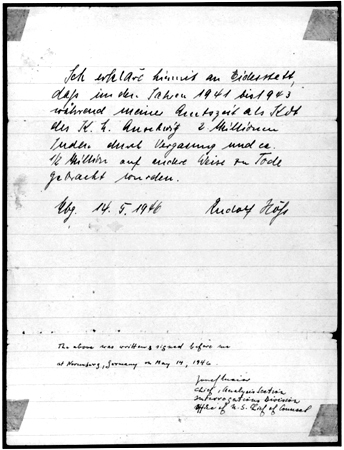
Auschwitz-Birkenau |
||
|

|
On May 14, 1946, the former Commandant of Auschwitz-Birkenau, Rudolf Höß, also known as Rudolf Hoess, signed a sworn affidavit in which he stated that two million Jews had been gassed at Auschwitz-Birkenau between 1941 and 1943 while he was the Commandant. This did not include the period, during which Hoess was not the Commandant, when over 300,000 Hungarian Jews were gassed during a period of 10 weeks in the Summer of 1944, according to the Auschwitz Museum. The English translation of the German text in the affidavit reads: "I declare herewith under oath that in the years 1941 to 1943 during my tenure in office as commandant of Auschwitz Concentration Camp 2 million Jews were put to death by gassing and a 1/2 million by other means. Rudolf Hoess. May 14, 1946." The confession was signed by Hoess and by Josef Maier of the US Chief of Counsel's office. The original affidavit, signed by Rudolf Hoess, is displayed in a glass case in the United States Holocaust Memorial Museum in Washington, DC. The photo that is displayed, along with the affidavit, shows Hungarian Jewish women and children walking to one of the four gas chambers in the Birkenau death camp on May 26, 1944, carrying their hand baggage in sacks. 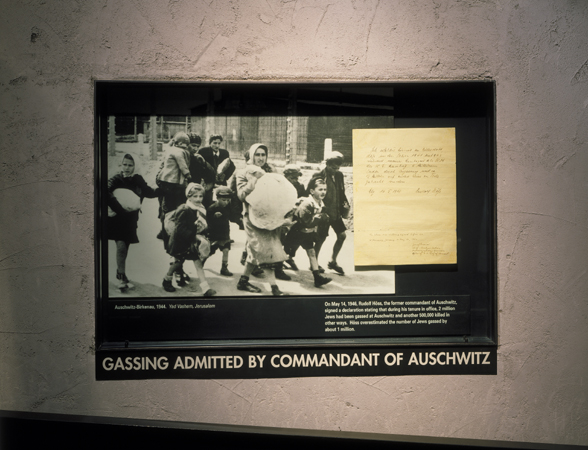 The caption underneath the photo above reads: On May 14, 1946, Rudolf Hoess, the former commandant of Auschwitz, signed a declaration stating that during his tenure in office, 2 million Jews had been gassed at Auschwitz and another 500,000 killed in other ways. Hoess overestimated the number of Jews gassed by about 1 million. There have been allegations that this confession was obtained from Rudolf Hoess by means of torture. Rupert Butler wrote in his book entitled "Legions of Death," published by Arrow Books in London in 1983, that Hoess had been beaten for three days by a British team of torturers under the command of Jewish interrogator Bernard Clarke. 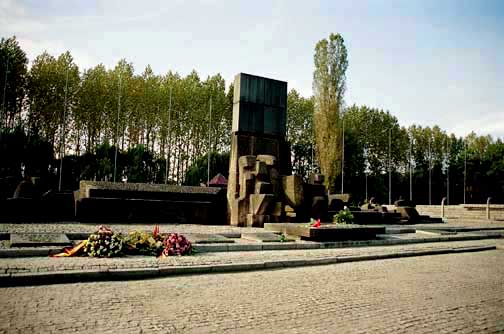 In April 1967, an International Monument, dedicated to the victims of Fascism, was unveiled at Birkenau, between the ruins of Krema II and Krema III, the two crematoria buildings where the two largest gas chambers were located. The monument included a series of granite plaques which informed visitors that 4 million people had been murdered by the Nazis at Auschwitz-Birkenau. This number was an estimate given by the Soviet Union on May 8, 1945, based on the maximum capacity of the cremation ovens in the main camp and Birkenau. Four million was the number of deaths at Auschwitz-Birkenau that the Soviet Union included in their war crimes charges against the Nazis at the Nuremberg International Military Tribunal in November 1945. The Soviet Union also charged that the Nazis had murdered 1.5 million people at the Majdanek death camp. Today, the Museum at Majdanek claims that 78,000 prisoners, including 59,000 Jews died at Majdanek. 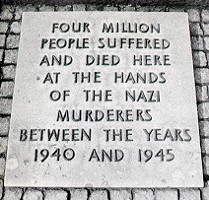 According to the Auschwitz Museum, after the fall of Communism in 1989, the Soviet Union turned over to the International Committee of the Red Cross 46 volumes of Death Books (Sterbebücher) which they had confiscated from the Auschwitz camp. These records, which were kept by the political department (Gestapo) at Auschwitz, show that there were around 69,000 registered prisoners who died between July 29, 1941 and December 31, 1943. The Death books from June 14, 1940 to July 28, 1941 are missing, as are the death books from all of 1944 and January 1945. Based on these records, the International Red Cross has estimated that a total of around 135,000 registered prisoners died in the three Auschwitz camps. These figures are for Jews and non-Jews. The document in the photo below, which shows records from the Nazi concentration camps, is stored at Arolsen, Germany. Click on the photo to enlarge it. 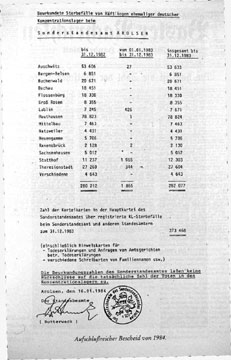 In 1990, the plaques with the figure of 4 million were removed. It was not until 1995 that new plaques were placed at the International Monument with 20 metal plates inscribed in Yiddish, English and all the major languages of Europe; the plaques were set on granite slabs on the steps of the International Monument. The number of deaths at Auschwitz, according to each of the 20 metal plates, is 1.5 million. As shown in the photo below, the English inscription reads: FOR EVER LET THIS PLACE BE A CRY OF DESPAIR AND A WARNING TO HUMANITY, WHERE THE NAZIS MURDERED ABOUT ONE AND A HALF MILLION MEN, WOMEN AND CHILDREN MAINLY JEWS FROM VARIOUS COUNTRIES OF EUROPE. AUSCHWITZ-BIRKENAU 1940-1945 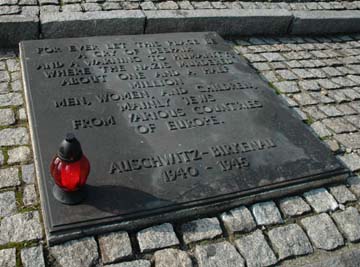 In 1980, Franciszek Piper, the director of the Auschwitz Museum, began a study of all the available documents at Auschwitz; he calculated that 1,077,180 prisoners, of which 90% were Jews, had died at Auschwitz, based on his estimate of the number of arrivals minus the number of liberated prisoners and the number of transferred, escaped and released prisoners. This number includes the Jews, not registered in the camp, who are assumed to have been gassed immediately upon arrival. In 1946, Rudolf Hoess was put on trial in Poland; he was charged with the murder of "around 300,000 people held at the camp as prisoners and entered into the camp's records and around 4,000,000 people, mainly Jews, who were brought to the camp in transports from other European countries for immediate extermination and thus not listed in the camp's records." During his trial, Höss changed the figure in his confession to a total of 1,130,000 Jews that were gassed but declared "During my tenure at Auschwitz, millions of people died, whose exact number I cannot determine." Rudolf Hoess wrote in his autobiography that Obersturmbannführer Adolf Eichmann and his deputy were the only ones who knew the total number of Jews that were gassed at Auschwitz-Birkenau because Reichsführer-SS Heinrich Himmler had ordered the records to be burned after every special action. The Nazis always used code words when talking about the genocide of the Jews: a mass gassing was called a "special action." In the last days of World War II, shortly before Berlin was surrounded by Soviet troops, Eichmann told Hoess that 2.5 million Jews had been murdered at Auschwitz Birkenau. Eichmann was an SS Lt. Col. who was the head of Department IV, B-4, the section of the Reich Central Security Office (RSHA) in Berlin, which was responsible for deporting the Jews. It was Adolf Eichmann who was in charge of deporting the Jews on the trains to the death camps. According to the Auschwitz Museum, no records of the number of prisoners who died at Auschwitz-Birkenau have ever been found. In an article on the official Auschwitz website, Franciszek Piper wrote the following: When the Soviet army entered the camp on January 27, 1945, they did not find any German documents there giving the number of victims, or any that could be used as a basis for calculating this number. Such documents (transport lists, notifications of the arrival of transports, reports about the outcome of selection) had been destroyed before liberation. For this reason, the Soviet commission investigating the crimes committed in Auschwitz Concentration Camp had to make estimates. [...] The absence of the most important of the statistical sources that the Germans kept in Auschwitz made it practically impossible for historians to research the issue of the number of victims. The reluctance to research this issue also resulted from a conviction of the impossibility of drawing up a full list of transports reflecting the total number of deportees, and above all of the people who were consumed by the gas chambers and crematoria with no registration or records. In his book entitled "IBM and the Holocaust," Edwin Black wrote that the Nazis tracked the prisoners by using IBM Hollerith machines which sorted punch cards that were coded with information about each prisoner. The numbers on the tattoos that were put on the arms of the Auschwitz prisoners, starting in 1943, were originally the prisoner's code number on his Hollerith card. The following is a quote from the book "IBM and the Holocaust" by Edwin Black: It was not just people who were counted and marshaled for deportation. Box cars, locomotives and intricate train time tables were scheduled across battle-scared borders - all while a war was being fought on two fronts. The technology had enabled Nazi Germany to orchestrate the death of millions without skipping a note. According to Edwin Black, the prisoners were not tracked with an IBM punch card until they were registered in a camp, so there are no records of those who arrived at Auschwitz, but were not registered. Of the millions of Hollerith punch cards used by the Nazis, only around 100,000 survived the war, according to Edwin Black. The generally accepted figure of 1.3 million who were deported to Auschwitz is not based on the train records kept by the Germans, but rather an estimate made by Franciszek Piper who wrote the following in his article on the official Auschwitz web site: After an overall analysis of the original sources and findings on deportation to Auschwitz, I concluded that a total of at least 1,300,000 people were deported there, and that 1,100,000 of them perished. Approximately 200,000 people were deported from Auschwitz to other camps as part of the redistribution of labor resources and the final liquidation of the camp. One of the most distinguished Holocaust researchers, Raul Hilberg, published a separate work (Auschwitz and the Final Solution) on the number of Auschwitz victims. His findings reaffirmed both the figure of 1,000,000 Jewish Auschwitz victims that he had arrived at as long ago as 1961, as well as my own conclusions. The IBM Hollerith punch cards kept by the Germans for the Jews, Russians and Gypsies, who were registered in the camp and later killed in the gas chambers, were coded as F-6 for "special treatment" or as "evacuations" according to Edwin Black, the author of "IBM and the Holocaust." The code for "execution" was D-4. In 2002, Edwin Black wrote the following in an article regarding the IBM Hollerith punch card machines in Krakow which were used by the Nazis to keep track of the Auschwitz prisoners: The machines almost certainly did not maintain extermination totals, which were calculated as "evacuations" by the Hollerith Gruppe in Krakow. Richard Seaver wrote in the Introduction to "Auschwitz, a Doctor's Eyewitness Account" by Dr. Miklos Nyiszli that "in 1944 German authorities destroyed the transport lists of all Jews who had been sent to Auschwitz up to that point, and in the succeeding months ordered the destruction of all other incriminating documents." The complete records, compiled by the office of Richard Glücks for all the Nazi concentration camps in the years 1935 to 1944, are now stored on microfilm and kept in the Russian Central Archives in the Central State Archives No. 187603 on Rolls 281 through 286. These records give statistics on the number of Auschwitz deaths from execution, typhus and other natural causes, but not the statistics on the Jews who were gassed. According to Wikipedia, Richard Glücks attained the rank of a SS-Gruppenführer and a Generalleutnant of the Waffen-SS and was, from 1939 until the end of World War II, the head of Amt D: Konzentrationslagerwesen of the WVHA and the highest-ranking "Inspector of Concentration Camps" in Nazi Germany. Close to Himmler, Glücks was directly responsible for the forced labour of the camp inmates; he was also the supervisor for the medical practices in the camps, ranging from human experimentation to the implementation of the Endlösung, in particular the mass murder of the inmates by gassing with Zyklon-B. Endlösung is the German term for "The Final Solution," which means the genocide of the Jews. Himmler and Glücks both escaped justice by committing suicide immediately after they were captured by the Allies in May 1945, before they could be interrogated. According to the records kept by the office of Richard Glücks, there was a total of 121,453 inmates, including 100,743 Jews who were transferred out of Auschwitz-Birkenau to other camps. The same records show that there was a total of 334,785 prisoners who entered Auschwitz-Birkenau between May 1940 and December 1944, including 161,785 non-Jews. The records kept by the office of Richard Glücks show that 103,429 inmates of Auschwitz-Birkenau died from typhus, including 58,240 Jews who died from typhus between 1942 and 1944. An additional 4,140 prisoners died of other natural causes between 1940 and 1944, including 2,064 Jews. The number of people executed at Auschwitz, according to the records stored on microfilm in the Russian Archives, was 1,646 including 117 Jews, 1,485 Poles, 19 Russians, 5 Czechs and 20 Gypsies. The German records kept by the office of Richard Glücks show that 173,000 Jews were brought to Auschwitz-Birkenau and that 100,743 were transferred to other camps; 58,240 Jews died of typhus; 2064 Jews died of natural causes and 117 Jews were executed, bringing the total number of Jewish deaths at Auschwitz-Birkenau to 60,421. At the end of October 1944, there were 11,836 Jews at Auschwitz-Birkenau, plus a few that were admitted to the camp in November and December 1944, according to the records kept by the office of Richard Glücks. The German records show that 161,785 non-Jews were brought to Auschwitz-Birkenau from May 1940 to December 1944 and that 45,189 of them died from typhus; 1,529 non-Jewish prisoners at Auschwitz-Birkenau were executed; 2,076 non-Jews died of natural causes, other than typhus. This makes a total of 48,794 non-Jewish deaths at Auschwitz-Birkenau in addition to the 60,421 Jewish deaths, for a combined total of 109,215. This does not include the deaths in January 1945 before Auschwitz was liberated on January 27, 1945. According to information presented at the Auschwitz Museum, 405,222 prisoners were registered at Auschwitz-Birkenau; the Jews who were immediately sent to the gas chamber were not registered and no records of any kind were kept for them. Out of the 405,222 prisoners who were registered at Auschwitz and Birkenau, around 340,000 died at Auschwitz and other camps to which they were transferred, according to a Museum guidebook, which I purchased in 2005. This figure includes the prisoners who were registered and then selected later for gassing because they were no longer able to work. By subtracting the number of prisoners still in the camp the day before it was abandoned, the number of prisoners sent to other concentration camps, and the number of escapees from the number of prisoners that were registered, the remainder is a number that closely matches the figure of 135,000 deaths that was estimated by the Red Cross. According to Franciszek Piper, the director of the Auschwitz Museum, there were approximately 500 prisoners who escaped from Auschwitz. The Encyclopedia of the Holocaust puts the total number of Hungarian Jews who died at Auschwitz-Birkenau between May and July 1944 at approximately 550,000, the majority of whom were gassed, but Lucy Dawidowicz wrote in her book entitled "The War Against the Jews," published in 1975, that 450,000 Hungarian Jews were brought to Auschwitz between May 1944 and October 1944. Raul Hilberg stated in his book entitled "The Destruction of the European Jews" that the number of Hungarian Jews brought to Auschwitz was 180,000. According to Franciszek Piper, the majority of the Hungarian Jews, who were sent to Auschwitz-Birkenau, were gassed immediately. A booklet purchased from the Auschwitz Museum stated that 434,351 of the Hungarian Jews were gassed upon arrival. If these figures are correct, only 3,051 Hungarian Jews, out of the 437,402 who were sent to Auschwitz, were registered in the camp. However, Franciszek Piper wrote that 28,000 Hungarian Jews were registered at Auschwitz-Birkenau. The records from the office of Richard Glücks show that only 23,117 Hungarian Jews were brought to Auschwitz-Birkenau and 21,527 Hungarian Jews were transferred out of the camp. On July 12, 1944, there were 92,705 prisoners in the whole camp complex, according to the roll call taken that day. In the main camp, there were 14,386 men. At Birkenau, there were 19,711 men and 31,406 women. There were 26,705 men in Auschwitz III. This total did not include the Hungarian Jews who were not registered, according to Danuta Czech. They were held in section B III of Birkenau, called Mexico, while they waited to be gassed or sent to another camp. On April 12, 1947, just before his execution, Rudolf Hoess signed the following Final Statement, in which he admitted his shame for committing Crimes Against Humanity and for participating in the genocide perpetrated by the Third Reich: My conscience is forcing me to make also the following assertion: In the isolation prison I have reached the bitter understanding of the terrible crimes I have committed against humanity. As a Kommandant of the extermination camp at Auschwitz, I have realized my part in the monstrous genocide plans of the Third Reich. By this means I caused humanity and mankind the greatest harm, and brought unspeakable suffering, particularly to the Polish nation. For my responsibility, I am now paying with my life. Oh, that God would forgive me my deeds! People of Poland, I beg you to forgive me! Just now in the Polish prisons have I recognized what humanity really is. In spite of everything that happened I have been treated humanely, which I had never expected, and this has made me feel deeply ashamed. Would to God...that the fact of disclosing and confirming those monstrous crimes against mankind and humanity may prevent for all future ages even the premises leading to such horrible events. Confession and Nuremberg Testimony of Rudolf HoessHistory of AuschwitzAuschwitz II - aka BirkenauSelections for gas chamber or laborAuschwitz III - aka MonowitzMonowitz gas chamber?Liberation of Auschwitz-BirkenauSurvivors of Birkenau campHomeThis page was last updated on Janurary 5, 2010 |